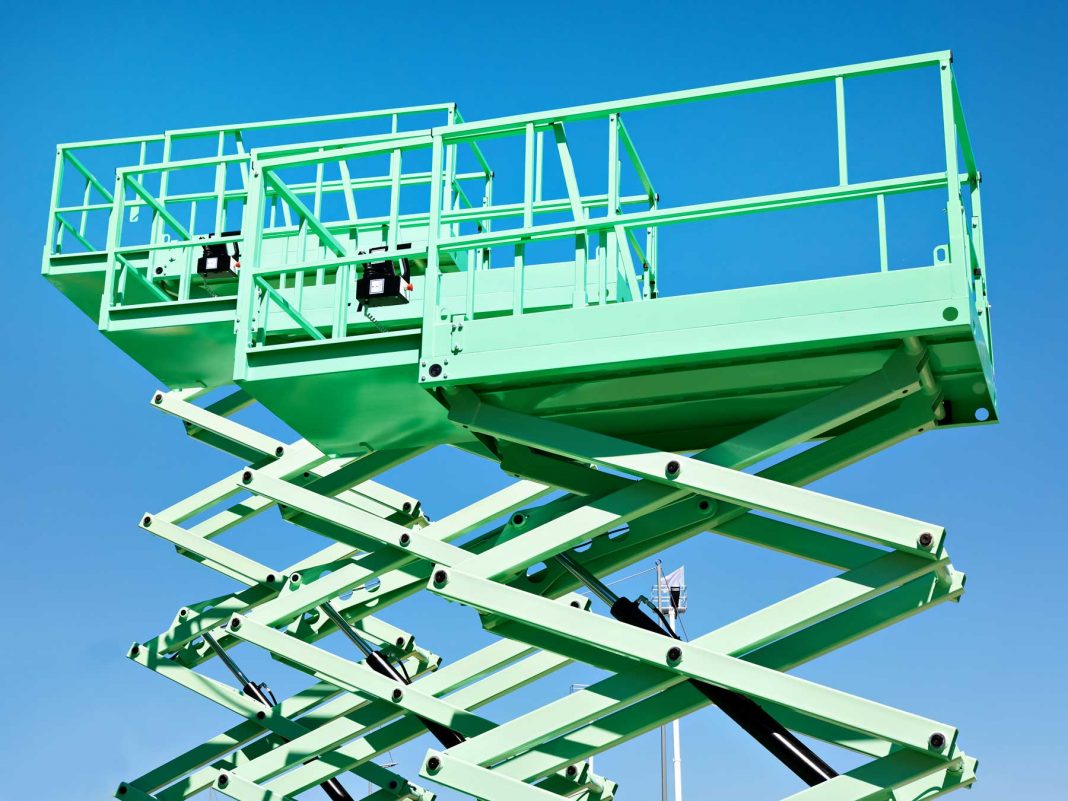Scissor lifts use cross balance supports to move up and down. The mechanism it uses to move the lift up and down depends on the way it’s powered.
Hydraulics, diesel, and electricity are just a few ways scissor lifts can be powered.
You’ll commonly find scissor lifts used for a variety of tasks from performing building repairs to reaching materials stored high in warehouses. We generally know what they do, but how does a scissor lift work?
To understand how a scissor lift works, take a look at our guide below to learn about the different parts of the lift, how its power sources affect its lifting mechanism, and how operators stay safe on a scissor lift.
Parts of a Scissor Lift
You need to first understand the parts of a scissor lift to understand how it works. We go over each basic scissor lift part below.

- Platform: These come in a variety of shapes, sizes, and densities depending on the model. Platforms with rails typically transport people, while ones without rails typically transport materials. The platform is also called a “lift table.”
- Base: Similarly, the size of the base also depends on the model. The base serves as the foundation of the lift and is made with rigid metal. It has tracks to guide rollers at the bottom of the scissor legs. These rollers, along with support from a strong base, ensure steady ascent and descent.
- Scissor legs: The legs extend from the base to the platform. They raise the platform as they constrict and lower the platform as they expand. The legs are in a pantograph or criss-cross pattern.
- Cylinder(s): A scissor lift will have between one and four cylinders attached to it. The cylinder’s contents depend on the type of scissor lift. For example, a hydraulic scissor lift has a cylinder filled with hydraulic fluid, while another type of cylinder called pneumatic pump fills with compressed air.
- Power source: The power source can range from a self-contained motor or a remote power pack. There are many ways a scissor lift is powered (we’ll go into more depth on power sources later on.)
- Down valve: This valve controls the flow of compressed air or hydraulic fluid by allowing it to go back into its original container. This ensures the scissor lift doesn’t descend too fast. The down valve isn’t activated until the power source activates it.
- Flow control valve: This valve handles the speed of the platform’s descent by managing how quickly the fluid or compressed air leaves the cylinder.
How a Scissor Lift Works
The way a scissor lift works depend on its power source, but the resulting movement is the same.

Here are the steps to how a scissor lift works:
- The power source is turned on and begins to fill the cylinder(s) with hydraulic fluid or compressed air.
- Hydraulic fluid or compressed air is pushed from one area to another.
- The cylinder is pushed outwards and causes the legs to push apart.
- The platform is raised.
When the operator wants to lower the scissor lift, they will release the pressure or fluid in the scissor lift to reverse the above process and begin the descent.
The speed it descends depends on how powerful the scissor lift is and how much weight the platform is carrying. If you expect to lift heavy materials, you should consider a more powerful scissor lift. For example, heavyweight makes it difficult for the engine to press liquid or air against the cylinder to push outward.
How Scissor Lifts are Powered
There are many types of scissor lifts available to you that vary mostly by their power source. Here are the different ways scissor lifts are powered.
- Hydraulics: Hydraulic scissor lifts use a hydraulic liquid in the cylinders to power their lifting mechanism. They’re easy to use and operators don’t typically need much training. These are best used for simple projects where speed and horsepower are not priorities.
- Pneumatic: Pneumatic scissor lifts use air pressure to raise and lower the scissor lift. They don’t emit by-products or fumes, so they’re a more sustainable option compared to others at the cost of less power. These are great options for smaller projects and indoor use.
- Diesel: Diesel scissor lifts are powered by diesel fuel. They’re very powerful and both carry more weight and employ a larger platform. However, these are best used for outdoor sites or areas with ventilation due to the emitted fumes and loud noise.
- Electric: Electric scissor lifts use a silent, powered mechanism. They are quiet, do not emit fumes and are normally less bulky in comparison to more powerful scissor lifts. They are great for use in tight spaces.
How Do Operators Stay Safe on Scissor Lifts?
Operating at great heights poses obvious safety risks for operators. Here are a few ways you can stay safe on a scissor lift.
- Conduct a pre-operation safety check to ensure everything works properly, including the brakes and emergency stop button.
- Confirm all crew members received training and are familiar with the scissor lift in use for the day.
- Clear the surrounding area of potential safety hazards.
Scissor lifts are ideal heavy equipment options for completing work in high areas in a safe and efficient way. Check out our wide selection to see what works best for your project.
Source: Big Rentz
Also Read
Top construction brands for the successful contractor

